 Another early snowstorm in the bee-yard.
Another early snowstorm in the bee-yard.
Sunday, November 15, 2009
Tuesday, November 10, 2009
2009 Harvest Summary
Another growing season gone and Thanksgiving is fast approaching, that means its time to review the year's harvest totals and give thanks for the blessings from our garden. As of Nov 10, most of the 2008 harvest is in(we still have a few carrots remaining). We had some challenges this year with the weather and the bees but we still got plenty to be thankful for.
We didn’t set any new records this year for production but we were above the average yield in several categories. A hail storm ravaged our garden on July 28th destroying a lot of the produce. Despite the damage we were still above average on our garlic, green beans and snow peas. We also added laying hens for fresh eggs this year. We have five layers that are produced as much as 30 eggs per week before the winter set in.
2009 harvest totals:
• Carrots 21.7 lbs (so far), 56% of average yield
• Cucumbers 26.3 lbs, 94% of average yield
• Eggs 25.6 dozen (new category)
• Garlic 5.2 lbs, 128% of average yield
• Green Beans 23.3 lbs, 139% of average yield
• Honey 107.5 lbs, 86% of average yield
• Beeswax 2 lbs
• Lettuce & Salad Greens 5.2 lbs, 86% of average yield
• Onions 1.5 lbs (volunteers)
• Peppers 23.8 lbs, 46% of average yield
• Rhubarb 5.4 lbs, 49% of average yield
• Snow Peas 8.8 lbs, 194% of average yield
• All Squash 83.4 lbs, 52% of average yield
• Tomatoes 172.9 lbs, 98% of average yield
2009 Climate Summary:
This summer's growing season was longer than normal and had an early start. This should have set us up for great harvests, but the hail came. We had our last frost of spring on April 19th and our first frost of the fall on October 2nd giving us a growing season of 166 days this year. We had good consistent rains from April through July this year, which was above average, but 64 days were rainy, which may have kept the bees inside more than normal at least partially accounting for our lower honey production. Our total summer rainfall was above normal with 9.8" from April through October with August being our driest month with only 0.12” for the month. September was also dry, so the late-summer required a lot of extra watering again this year.
It was also a cool summer with average temps peaking at only 69°F in July, and once again with no days above 100 degrees. The maximum temp for the entire summer was only 96°F on July 24th.
We didn’t set any new records this year for production but we were above the average yield in several categories. A hail storm ravaged our garden on July 28th destroying a lot of the produce. Despite the damage we were still above average on our garlic, green beans and snow peas. We also added laying hens for fresh eggs this year. We have five layers that are produced as much as 30 eggs per week before the winter set in.
2009 harvest totals:
• Carrots 21.7 lbs (so far), 56% of average yield
• Cucumbers 26.3 lbs, 94% of average yield
• Eggs 25.6 dozen (new category)
• Garlic 5.2 lbs, 128% of average yield
• Green Beans 23.3 lbs, 139% of average yield
• Honey 107.5 lbs, 86% of average yield
• Beeswax 2 lbs
• Lettuce & Salad Greens 5.2 lbs, 86% of average yield
• Onions 1.5 lbs (volunteers)
• Peppers 23.8 lbs, 46% of average yield
• Rhubarb 5.4 lbs, 49% of average yield
• Snow Peas 8.8 lbs, 194% of average yield
• All Squash 83.4 lbs, 52% of average yield
• Tomatoes 172.9 lbs, 98% of average yield
2009 Climate Summary:
This summer's growing season was longer than normal and had an early start. This should have set us up for great harvests, but the hail came. We had our last frost of spring on April 19th and our first frost of the fall on October 2nd giving us a growing season of 166 days this year. We had good consistent rains from April through July this year, which was above average, but 64 days were rainy, which may have kept the bees inside more than normal at least partially accounting for our lower honey production. Our total summer rainfall was above normal with 9.8" from April through October with August being our driest month with only 0.12” for the month. September was also dry, so the late-summer required a lot of extra watering again this year.
It was also a cool summer with average temps peaking at only 69°F in July, and once again with no days above 100 degrees. The maximum temp for the entire summer was only 96°F on July 24th.
Sunday, October 18, 2009
Fall Beehive Inspections
We had a wonderful weekend with highs in the 70s and low 80s and light winds. It was ideal to do an inspection of our beehives to see if they are ready for winter. It was mostly bad news again.
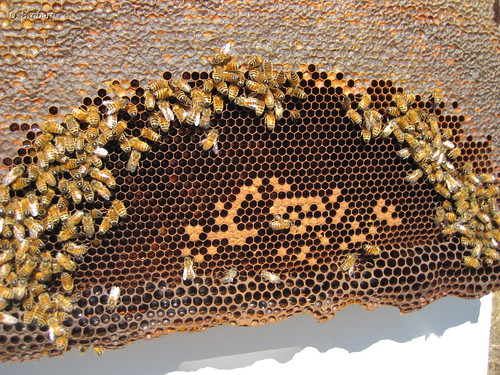
This is one of the center frames from the upper box of Hive #1 (survivor colony). They have a bit more honey in the edges of the box, but they are in bad shape regarding reserves and will starve without more honey.
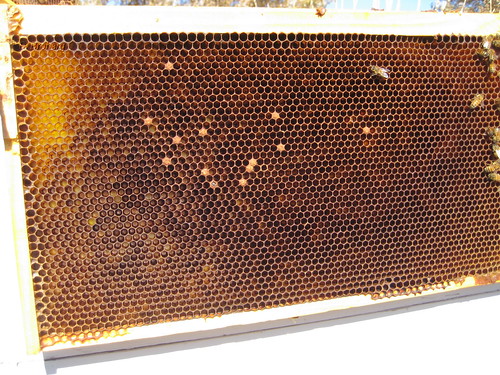
This is brood chamber (lower) from Hive #1. As you can see there is nearly no brood and we saw no larvae and no eggs. This looks like a death sentence for this colony. We put on a pollen patty and will start feeding winter syrup, but it may be too late.
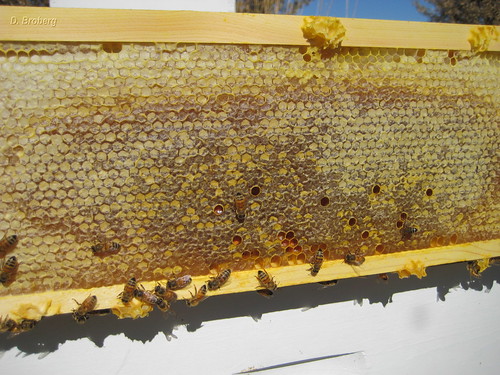
This frame is from the upper box of Hive #2 (feral colony). They seem to have one box full of honey, with a bit more in the middle box. We harvested nothing from this colony this year.
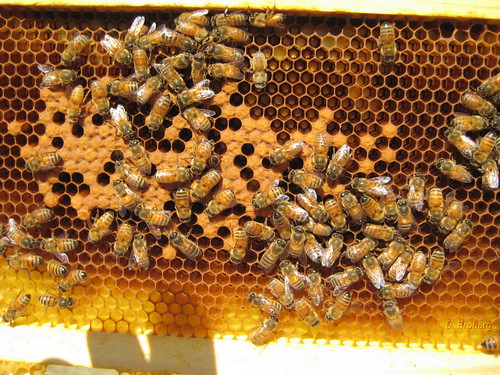
This frame is from the middle box of Hive #2. There was some capped brood, but we saw almost no larvae or eggs.

This frame is the honey stores from the upper chamber of Hive #3 (2009 package colony).
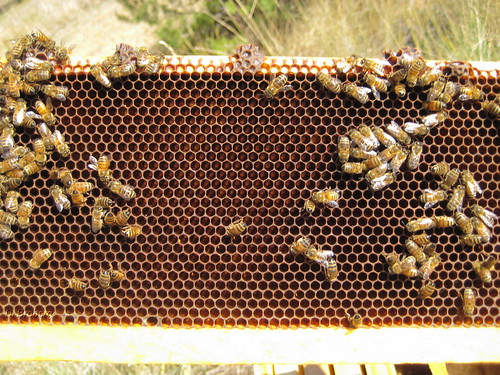
This frame is from the center brood chamber of hive #3. Where is the brood?

Lower level frame from hive #3. No brood, no pollen, no honey.
We put pollen patties on all three hives to try to encourage some new brood, but it looks like it's going to be a tough winter for our bees.

This is one of the center frames from the upper box of Hive #1 (survivor colony). They have a bit more honey in the edges of the box, but they are in bad shape regarding reserves and will starve without more honey.

This is brood chamber (lower) from Hive #1. As you can see there is nearly no brood and we saw no larvae and no eggs. This looks like a death sentence for this colony. We put on a pollen patty and will start feeding winter syrup, but it may be too late.

This frame is from the upper box of Hive #2 (feral colony). They seem to have one box full of honey, with a bit more in the middle box. We harvested nothing from this colony this year.

This frame is from the middle box of Hive #2. There was some capped brood, but we saw almost no larvae or eggs.

This frame is the honey stores from the upper chamber of Hive #3 (2009 package colony).

This frame is from the center brood chamber of hive #3. Where is the brood?

Lower level frame from hive #3. No brood, no pollen, no honey.
We put pollen patties on all three hives to try to encourage some new brood, but it looks like it's going to be a tough winter for our bees.
Monday, September 21, 2009
Honey Harvest 2009

Well it has been a tough year for the bees. Our bees only produced 1/3 of what they did last year. The total production this year was just over 100 lbs, making this liquid gold even more precious this year.
We're really not sure what happened though. The newbees we purchased in April that gave us fits with the failed queen release have been nothing but trouble this year. They were supposed to be Minnesota Hygienic bees, but I'm not so sure. They don't behave at all like those we've had before. The queen must be a party animal, she is very productive and the colony built up very fast and very strong. This new colony is also the most aggressive bees we've ever had - they are HOT! The last few times we've been out to visit the hives, just as soon as we take the lid of of these hundreds come pouring out and go straight for your face with aggression. It wouldn't be so bad if that is what we were accustomed to, but the other colonies are gentle lady-bugs by comparison.
The other thing strange about this colony was the unusual open patterns in the honey frames as shown in the photo in the previous post. Even at harvest, we found nearly all of the frames half-empty, and dotted with pollen as shown below - very strange. This really reduced our harvest. It was not as if they had been raided or even got hungry, rather the open parts were never touched. I'm putting blame on bad genetics and we'll replace the queen.
The survivor colony was slow building up in the spring and slow to fill the honey supers too. There was nothing particularly unusual about them this year, no ailments, just generally not very strong. Looks like another candidate for queen replacement, should they actually survive the winder again.
Finally we have the feral colony we rescued from a tree. They seem strong enough, but not too aggressive. But we got them so late they didn't really have any opportunity to compete for production this year. They now seem to have a good population and hopefully they'll survive the winter and be our most productive colony next year. We'll see. Maybe they will produce another queen we can use on one of the other colonies too.
Saturday, July 25, 2009
Honey progress
Well it is late July and we have a total of 5 honey supers now installed on the three colonies. We installed the first one today on the new colony we captured as a swarm in June. We did an inspection of the others today and there was some mixed news.
The survivor colony was doing well and got its second super just one week ago. Today they have done a good job of filling most of it with nectar, but nothing capped yet. The patters look typical (see the photo below):

Now we moved down to the new colony of Minnesota Hygienics we started from a package in April. We noticed something strange as we pulled a few frames out for inspection. One edge was completely capped and the other edge had untouched comb, with some spotty places where there seemed to be pollen being stored. (This hive has a queen excluder installed.) Here is a picture of the pattern:

Here is a close-up of some of the pollen on that same frame:
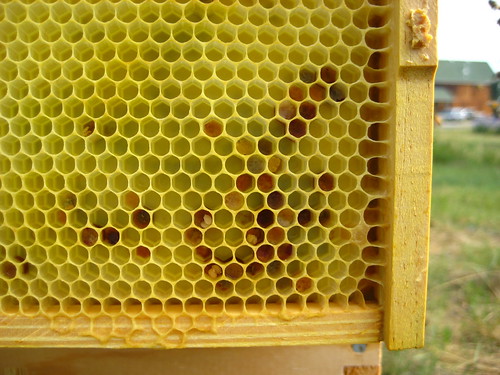
So what is going on with this colony and the honey?
The survivor colony was doing well and got its second super just one week ago. Today they have done a good job of filling most of it with nectar, but nothing capped yet. The patters look typical (see the photo below):

Now we moved down to the new colony of Minnesota Hygienics we started from a package in April. We noticed something strange as we pulled a few frames out for inspection. One edge was completely capped and the other edge had untouched comb, with some spotty places where there seemed to be pollen being stored. (This hive has a queen excluder installed.) Here is a picture of the pattern:

Here is a close-up of some of the pollen on that same frame:

So what is going on with this colony and the honey?
Thursday, July 02, 2009
First Eggs!

July 2nd, 2009: Our chicks are nearly 16 weeks old and we got our first eggs today. One little egg and a medium sized one. We're not sure which hens were responsible but based on their maturity, probably Beau and/or Ankita.
Tuesday, June 23, 2009
June Update
With all the rain we've had this spring, the wildflowers are going crazy this year, but the bees are not. Perhaps it's been too wet for them or just too cool, but they have not built up very fast nor filled the added space we gave them a few weeks ago and have done little or nothing with the honey supers we put on. The one survivor colony is building up rather slowly and the brood patterns have not been very good. The queen is showing her age.
The new colony has built up faster and seems to have a good queen, but they are still a new colony and haven't done much with the honey yet.
On this past Sunday, we found this swarm in one of our trees:
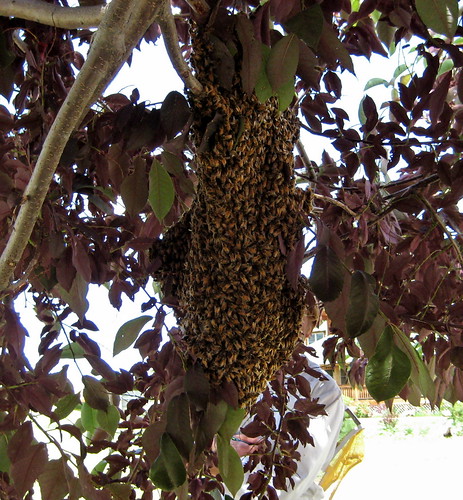
Fortunately for us, it was not very high so it was easy to remove and capture. We're pretty sure it was not from one of our hives since they have been struggling. We scrounged some spare parts and kludged a new hive together to put them into. We learned the lesson from the last swarm capture that escaped and we taped up the entrance hole for 2 days before letting them out. So far they seem to be settling into their new home. So hopefully they won't leave and we'll have some "freebees"!
The new colony has built up faster and seems to have a good queen, but they are still a new colony and haven't done much with the honey yet.
On this past Sunday, we found this swarm in one of our trees:

Fortunately for us, it was not very high so it was easy to remove and capture. We're pretty sure it was not from one of our hives since they have been struggling. We scrounged some spare parts and kludged a new hive together to put them into. We learned the lesson from the last swarm capture that escaped and we taped up the entrance hole for 2 days before letting them out. So far they seem to be settling into their new home. So hopefully they won't leave and we'll have some "freebees"!
Monday, May 25, 2009
Spring build-up
May 16th: We did a hive inspection and found that both colonies seemed to be thriving and needed more space. Since this is peak swarming season around here, we wanted to be careful and make sure they didn't feel crowded. The spring fruit trees were also peaking a bit later than usual this year, so we also wanted to try to capture some of the nectar flow.
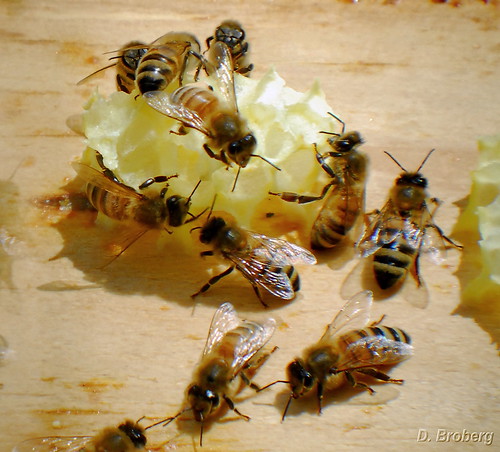
Click here to see a 3D version of this picture (use red-cyan 3d glasses).
We added the third brood box to the new colony. On the survivor colony we installed the queen excluder and the first honey super. During the inspection of this hive I caught a brief look at the queen, which hadn't been seen in almost a year. She is still productive, but the brood patterns weren't quite as impressive as last year.
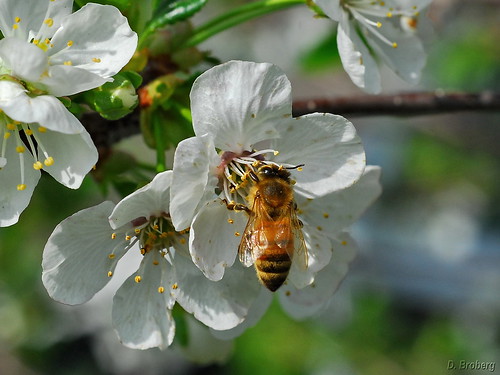
Honeybee on our cherry blossoms.
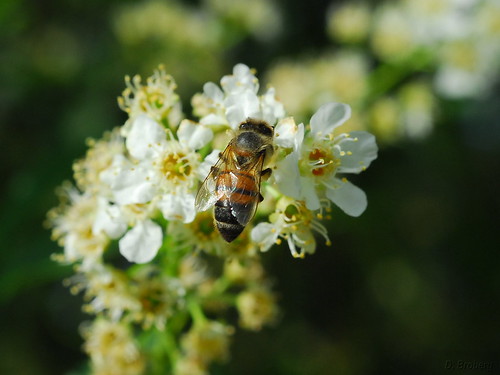
Honeybee on our chokecherry blooms.
May 25th: We've had quite a bit of rain and the bees have been busy. I opened the hives up briefly to see how things were progressing. On the new colony I saw some new larvae in the recently installed frame, but no capped honey. I was hoping this hive would be ready for the first honey super, but it was not.
On the survivor colony I hoped to see some progress with the honey, but there was 0% capped and it seemed as if those bees returning to the hive were simply ignoring the new super and going straight down to the brood chamber with their loads. Perhaps it was not quite as ready as I expected.
June is just around the corner and with all the recent rain there should be a good nectar flow coming.

Click here to see a 3D version of this picture (use red-cyan 3d glasses).
We added the third brood box to the new colony. On the survivor colony we installed the queen excluder and the first honey super. During the inspection of this hive I caught a brief look at the queen, which hadn't been seen in almost a year. She is still productive, but the brood patterns weren't quite as impressive as last year.

Honeybee on our cherry blossoms.

Honeybee on our chokecherry blooms.
May 25th: We've had quite a bit of rain and the bees have been busy. I opened the hives up briefly to see how things were progressing. On the new colony I saw some new larvae in the recently installed frame, but no capped honey. I was hoping this hive would be ready for the first honey super, but it was not.
On the survivor colony I hoped to see some progress with the honey, but there was 0% capped and it seemed as if those bees returning to the hive were simply ignoring the new super and going straight down to the brood chamber with their loads. Perhaps it was not quite as ready as I expected.
June is just around the corner and with all the recent rain there should be a good nectar flow coming.
Saturday, May 16, 2009
Springtime Blossoms
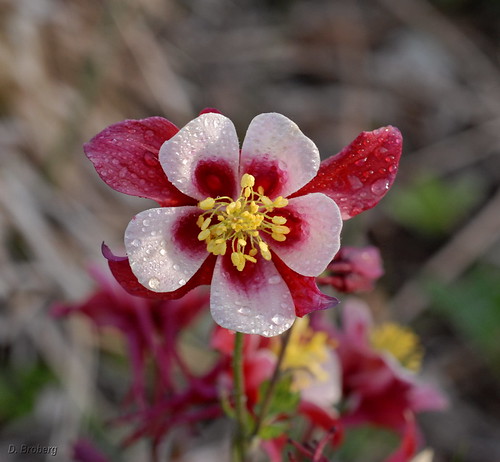
Red Columbine in our cutting garden.

The first iris of spring.

3D Lilac blossoms (you'll need the 3D anaglyph glasses to view)
Sunday, May 03, 2009
Queen Updates
We opened up the new colony of hygienic bees today to check to see if the queen we released last week has been accepted and is productive. There was good news as she has been busy and there was some good brood now at various stages. Here is the picture:
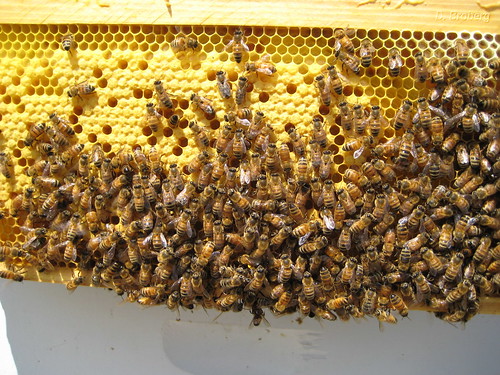
It looks like the new queen was ready and waiting and is now working hard.
On to hive #1 and last year's Minnesota Hygienic colony; they seem to have fully survived the winter and we finally found the queen today. There was some good brood pattens on some frames, but also some spotty brood patterns on others. We rotated the deep boxes this time too.

It looks like the new queen was ready and waiting and is now working hard.
On to hive #1 and last year's Minnesota Hygienic colony; they seem to have fully survived the winter and we finally found the queen today. There was some good brood pattens on some frames, but also some spotty brood patterns on others. We rotated the deep boxes this time too.
Sunday, April 26, 2009
Introducing... Chickens
We just became "chicken-keepers". Here are a few pictures introducing the new chicks at six weeks:
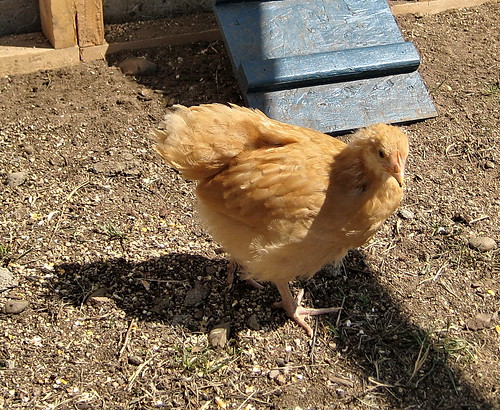
"Ginger" is a Buff Orpington and is very friendly. She is the first one to come running to greet people. Click here to see Ginger in 3D (anaglyph 3D glasses needed)
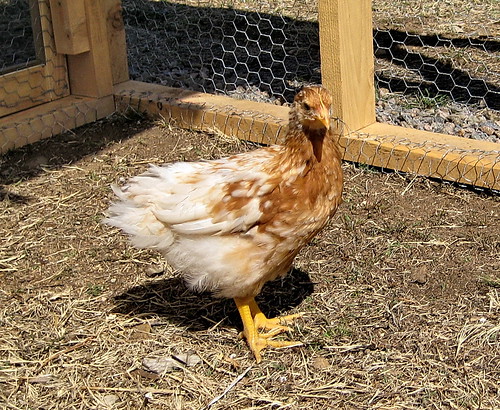
Above is Beau-Peep. When she was a young chick, she looked just like one of those marshmallow Peeps you see around Easter. She is a Red Star and is friendly and even tempered. Click here to see the 3D image of Beau (anaglyph 3D glasses required).
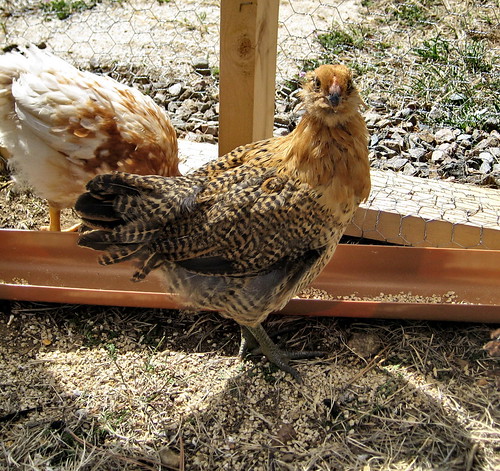
Next is Gracie. She is named Gracie because she lays blue and green colored eggs or "Easter Eggs". She is an Araucana/Americana and is very shy and skittish around people and does not like to be handled. She is a beautiful bird and notice she has green skin on her legs and feet! Click here to see the 3D image of Gracie (anaglyph 3D glasses required).
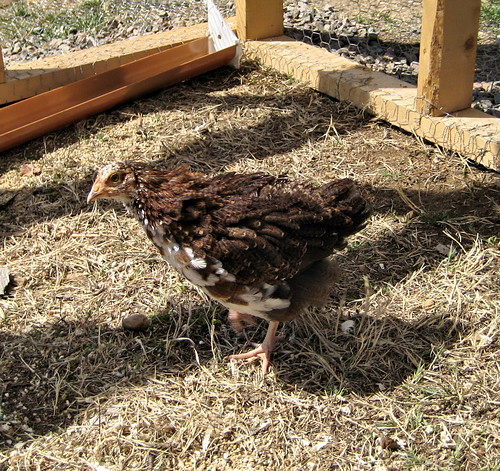
This is Leia, a Speckled Sussex. She is a little shy, but will take food from your hands and will lay brown eggs. Click here to see the 3D image of Leia (anaglyph 3D glasses required).

Finally we have Ankita the Plymouth (Barred) Rock. She is friendly and even tempered. She will also lay light brown or pinkish eggs. Click here to see the 3D image of Ankita (anaglyph 3D glasses required).
Below is a photo of their new chicken coop and run:
 We have to net the top of the run, to keep the hawks and eagles from stealing our chickens. The coop was painted to match our barn.
We have to net the top of the run, to keep the hawks and eagles from stealing our chickens. The coop was painted to match our barn.

"Ginger" is a Buff Orpington and is very friendly. She is the first one to come running to greet people. Click here to see Ginger in 3D (anaglyph 3D glasses needed)

Above is Beau-Peep. When she was a young chick, she looked just like one of those marshmallow Peeps you see around Easter. She is a Red Star and is friendly and even tempered. Click here to see the 3D image of Beau (anaglyph 3D glasses required).

Next is Gracie. She is named Gracie because she lays blue and green colored eggs or "Easter Eggs". She is an Araucana/Americana and is very shy and skittish around people and does not like to be handled. She is a beautiful bird and notice she has green skin on her legs and feet! Click here to see the 3D image of Gracie (anaglyph 3D glasses required).

This is Leia, a Speckled Sussex. She is a little shy, but will take food from your hands and will lay brown eggs. Click here to see the 3D image of Leia (anaglyph 3D glasses required).

Finally we have Ankita the Plymouth (Barred) Rock. She is friendly and even tempered. She will also lay light brown or pinkish eggs. Click here to see the 3D image of Ankita (anaglyph 3D glasses required).
Below is a photo of their new chicken coop and run:
 We have to net the top of the run, to keep the hawks and eagles from stealing our chickens. The coop was painted to match our barn.
We have to net the top of the run, to keep the hawks and eagles from stealing our chickens. The coop was painted to match our barn.
Friday, April 24, 2009
Queen release and other troubles
Well last weekend was cold and rainy and we weren't able to check up on the newly installed colony. I took today off and it was warm and dry, so we went to check to see how the bees were doing. We expected to see all the burr comb in the empty space where the queen cage was hanging, but we didn't expect to see the new Queen still inside the cage! To our horror the bees did not eat through the marshmallow and release her in 13 days. Instead they built burr comb over the opening, sealing her inside.
She was still alive and being fed by attendants through the screen. We quickly released her and she dropped into the hive with her attendants. But was it too late? Some of the burr comb had a new queen cell. It takes 16 days to produce a new queen, but when did they give up on the caged queen and decide to produce another? Will she be accepted now? Will she begin producing? Stay tuned for another update next week.
On to the surviving colony from last year. This hive was weak, but somehow survived the winter. There was new brood, but we did not find the queen. The brood patterns looked good and there was still some stored honey remaining. We hope this colony is now past the worst and will recover fully. Here is a picture of the brood from today's inspection:
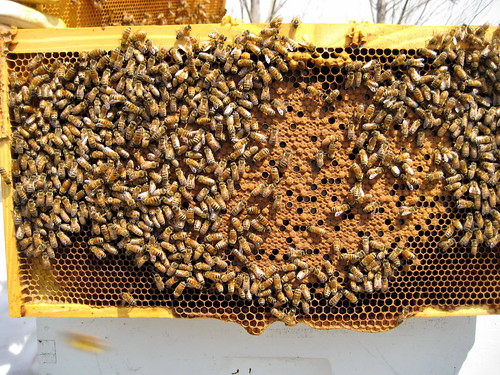
We had some good rain last week and everything is greening up nicely. The dandelions are in full bloom and our fruit trees are just about to pop. We hope this translates into a good nectar flow soon.
She was still alive and being fed by attendants through the screen. We quickly released her and she dropped into the hive with her attendants. But was it too late? Some of the burr comb had a new queen cell. It takes 16 days to produce a new queen, but when did they give up on the caged queen and decide to produce another? Will she be accepted now? Will she begin producing? Stay tuned for another update next week.
On to the surviving colony from last year. This hive was weak, but somehow survived the winter. There was new brood, but we did not find the queen. The brood patterns looked good and there was still some stored honey remaining. We hope this colony is now past the worst and will recover fully. Here is a picture of the brood from today's inspection:

We had some good rain last week and everything is greening up nicely. The dandelions are in full bloom and our fruit trees are just about to pop. We hope this translates into a good nectar flow soon.
Sunday, April 12, 2009
A Fresh Start
We got a new package of Minnesota Hygienic bees and put them in this weekend. Between the cloud cover and rain, there was only a narrow window where it was warm enough and we took advantage.
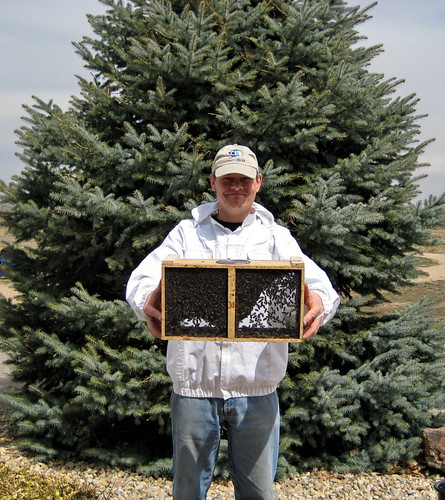
See a 3D version of this picture here.
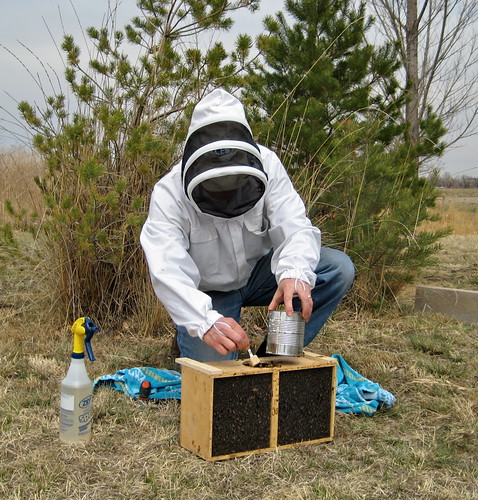
Removing the queen cage from the package.
View a 3D version of this picture here.
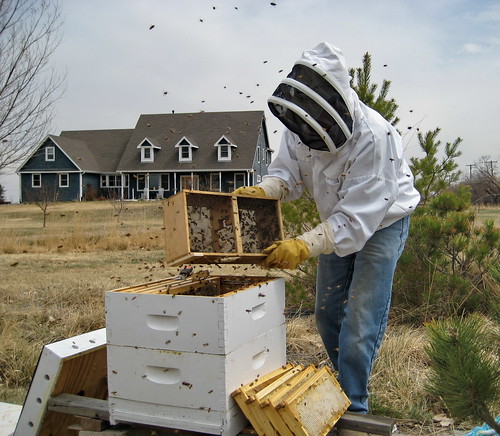
Shaking the bees into their new home.
View a 3D version of this photo here.
BTW, Becky was the excellent sterographer for these pictures.

See a 3D version of this picture here.

Removing the queen cage from the package.
View a 3D version of this picture here.

Shaking the bees into their new home.
View a 3D version of this photo here.
BTW, Becky was the excellent sterographer for these pictures.
Saturday, March 14, 2009
Colony Collapse Disorder?
It was a warm sunny day today and fearing the worst after seeing no activity from the hive in the past few weeks, I opened up the Italian hive today to find them substantially gone:
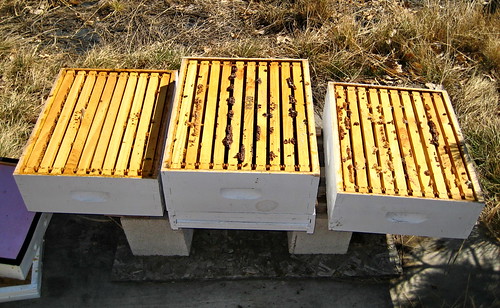
There was about 40lbs of honey still in the hive, so they didn't starve. It has been a mild winter and they have been well protected, so they didn't freeze. In today's inspection I found only a small handful of bees still present:

These few remaining bees were just barely alive and hardly moving. They were as good as dead (RIP). I did not find a queen present and there has been no brood of any kind since last fall. These were very productive bees during the last season and always were gentle. They will be missed, but replaced by another colony of Minnesota Hygienic Bees coming next month.
We also inspected the other colony of Minnesota Hygienics today. They are still very much alive and seem as vigorous as usual. They were out gathering pollen from somewhere and still had a good population and significant honey stores. However we are still concerned as we did not find any brood in the larvae stage today. While we did not spot the queen, it looks like she must be there somewhere. There were no queen cells and only a very small quantity of capped brood.
More info on CCD (videos): TED

There was about 40lbs of honey still in the hive, so they didn't starve. It has been a mild winter and they have been well protected, so they didn't freeze. In today's inspection I found only a small handful of bees still present:

These few remaining bees were just barely alive and hardly moving. They were as good as dead (RIP). I did not find a queen present and there has been no brood of any kind since last fall. These were very productive bees during the last season and always were gentle. They will be missed, but replaced by another colony of Minnesota Hygienic Bees coming next month.
We also inspected the other colony of Minnesota Hygienics today. They are still very much alive and seem as vigorous as usual. They were out gathering pollen from somewhere and still had a good population and significant honey stores. However we are still concerned as we did not find any brood in the larvae stage today. While we did not spot the queen, it looks like she must be there somewhere. There were no queen cells and only a very small quantity of capped brood.
More info on CCD (videos): TED
Sunday, January 18, 2009
Warm January Day
Still concerned about the survival of our bees this winter, I took advantage of the warm weather today to have a look at the Italian colony, which is the one that seemed to be in the most trouble. The good news was they are still alive!
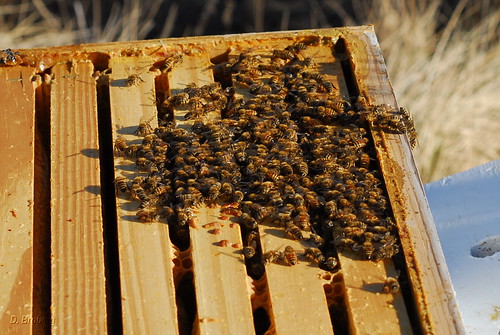
This photo shows a rather small cluster pattern for a warm day, which confirms the lower population of this colony.
The most amazing thing was that there was now MORE honey stores than we had placed in the hive during the November 1st inspection, when we first noticed they were in trouble.
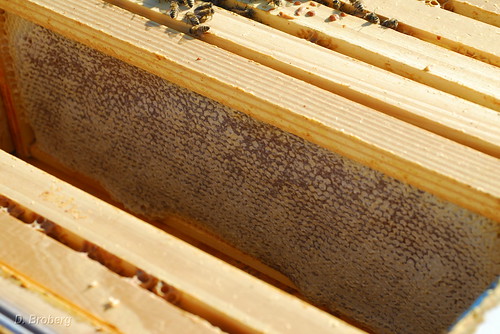
I counted six full frames about like this one mostly untouched in the upper box. Even those in the very center had not been consumed.
We were encouraged by these findings today and still hold out hope that both colonies will survive through the winter.

This photo shows a rather small cluster pattern for a warm day, which confirms the lower population of this colony.
The most amazing thing was that there was now MORE honey stores than we had placed in the hive during the November 1st inspection, when we first noticed they were in trouble.

I counted six full frames about like this one mostly untouched in the upper box. Even those in the very center had not been consumed.
We were encouraged by these findings today and still hold out hope that both colonies will survive through the winter.
Sunday, January 11, 2009
January Wildfires!
This week we had the Chinook winds, which are typical for this time of year. We had some wind gusts that peaked at 55 MPH and lost some shingles from the house. But these warm, dry winds also accelerated a local wild fire in central Boulder County. At a time when snow is usually covering the ground, it seems odd to have fires this time of year.
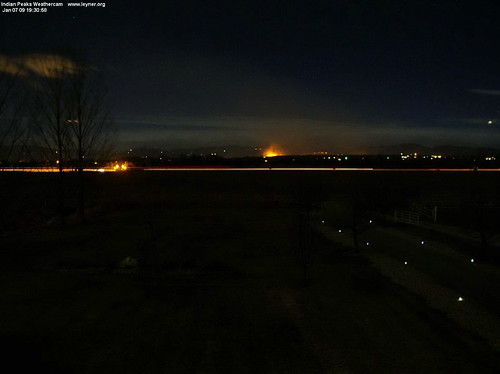
The Old Stage/Neva fire can be seen from our webcam snapshot above as the bright flare in the center of the image. Click the photo to see the full size, high resolution image.
The Daily Camera map below shows the exact location of the damage, which was about 8.6 miles west of our house.

Daily Camera News Story
Photo and video Gallery of fire
The Satellite image below is from the RockyMountain News story:

High-resolution DigitalGlobe satellite Imagery (PDF)
Denver Weather Examiner Story here.

The Old Stage/Neva fire can be seen from our webcam snapshot above as the bright flare in the center of the image. Click the photo to see the full size, high resolution image.
The Daily Camera map below shows the exact location of the damage, which was about 8.6 miles west of our house.

Daily Camera News Story
Photo and video Gallery of fire
The Satellite image below is from the RockyMountain News story:

High-resolution DigitalGlobe satellite Imagery (PDF)
Denver Weather Examiner Story here.
Subscribe to:
Posts (Atom)





